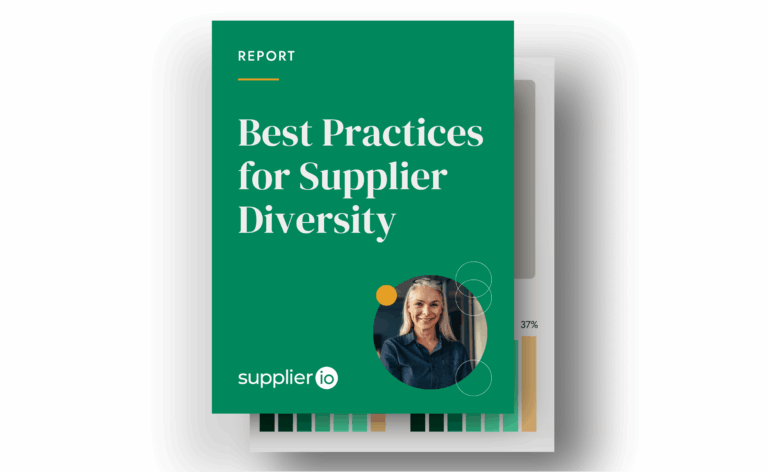A Data-Driven Approach to Scope 3 GHG Measurements and Action
Get a baseline and start measuring your Scope 3 greenhouse gases today with the data already at your fingertips.

In the global pursuit of sustainability and climate action, understanding and mitigating greenhouse gas (GHG) emissions have become paramount. While many organizations focus on direct emissions (Scope 1) and those from purchased energy (Scope 2), an often underestimated and overlooked aspect is Scope 3 emissions. Scope 3 emissions include the purchased goods and services your organizations buys. These emissions can be up to 90% of the organization’s total emissions. So tacking Scope 3 is critical to any carbon or net zero initiative.
This was the focus of a recent Supplier.io webinar titled: Better Scope 3 Data and Tackling the Net Zero Challenge.
Where to start
While your supply chain may hold the biggest opportunity for reducing greenhouse gases, it’s also the biggest challenge. This data on Scope 3 carbon emissions doesn’t sit within the walls of your organization. Now you have to rely on the data and collaboration with potentially thousands of suppliers. And that has already proven challenging.
“Supplier sustainability data that you need is very fragmented across various providers and data sources.” Said Aylin Basom, CEO of Supplier.io. “This makes it very hard for organizations to track and know the real impact of their suppliers and supply chain.”
But it doesn’t have to be. There are a few simple ways you can start immediately and then layer in more data and details as your program matures and as you better identify possible risks. Similar to what we’ve seen working with supplier diversity, getting a baseline for Scope 3 GHG is the necessary first step. But pulling that data together may seem impossible.
“We struggle to get suppliers to provide this information.” Commented one webinar attendee. “Maybe we need to re-write our contracts?” Turning to contracts is a common approach, but there are other ways to start that sit within your control and data today.
Starting with Spend
To address this challenge, companies are increasingly turning to spend-based reporting approaches, which consider the carbon footprint associated with purchased goods and services. This methodology offers a holistic view of emissions based on the data you already have. In this approach you start with dollars spent on specific goods and services by your company and based on industry standards, estimate the likely carbon emitted from them. So the purchase of air travel will have a different carbon footprint from buying office supplies or business services.
One of the primary advantages of a spend-based approach is its ability to provide a holistic measurement of an organization’s carbon footprint. You have easy access to your spend data and it provides standard analysis across business units as well as industry peers. By considering the entire value chain, you can gain a comprehensive understanding of your indirect emissions. This broader perspective enables more informed decision-making and targeted emissions reduction strategies.
Adding supplier specific data
Once you have a standard baseline across all your suppliers, you can start to layer in more supplier specific details. You don’t want to treat an Eco Vadis certified supplier the same as one that is not certified. Two suppliers with different CDP scores should be estimated differently. By pulling in publicly available information you’re able to fine tune your spend estimates without the difficulty of getting all your suppliers to report their specific GHG emissions.
Identifying Hotspots and Opportunities
Spend-based tracking is one great approach to help you identify emission hotspots and opportunities for improvement within the supply chain. By analyzing spending patterns, you can pinpoint areas with the highest emissions intensity and strategically focus on mitigating actions. This targeted approach allows for more efficient resource allocation and emission reduction efforts.
Some organizations are also identifying their biggest suppliers as measured by pure spend. This can give you an idea of your most critical suppliers, not just your biggest emitters. If you’re going to engage suppliers in your net zero initiative, they should probably be on your list as well.
Capture Supplier-specific data
With your high priority and potentially high risk suppliers identified, you know have a more targeted list for who you need more detailed data from. Now you have to capture it. This is where those contracts and your supplier registration portal can be so helpful. Leaders are reaching out to these critical suppliers to get them to provide more detailed information on their social and environmental policies as well as capturing their specific carbon footprint. To make life easier for your suppliers, try to take advantage of already public information such as their ESG reports or other disclosures. The easier it is for your suppliers the more likely they are to comply. You also want to make sure any data collected is in alignment with global standards. More and more regulations are rolling out globally and you don’t want to have to keep going back to get more data. Many organizations are basing their detailed risk analysis on the UN Sustainable Development Goals (SDGs).
Conclusion
Scope 3 greenhouse gas tracking represents a critical step in the journey toward a sustainable future. As companies grapple with the complexities of indirect emissions, spend-based approaches offer a great starting point and a baseline for improvement. The key lies in striking a balance – combining spend-based approaches with other measurement methodologies and verification mechanisms. Collaborative initiatives, industry standards, and technological advancements can enhance the accuracy and reliability of data collection.




